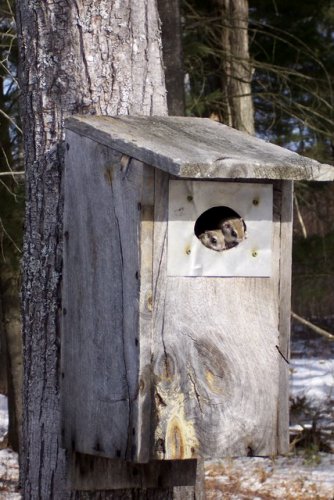A big surprise was waiting for me when I started to clean out a wooden duck box on an old maple tree along our frozen pond. As I opened the side door of the box, several flying squirrels were looking back at me from a bed of dry leaves and grass. My sudden intrusion into the privacy of their cozy winter quarters was too much for their comfort, and a few flying squirrels came scampering out from the box’s front entrance – and up the tree they climbed. I watched in amazement as one of them leaped off the tree, became airborne as he “spread his wings,” and landed on the trunk of a nearby tree.
Actually, flying squirrels do not fly, they glide. I watched as another flying squirrel gracefully took to the air. Walking a short distance from the box, I waited to see what would happen. Sure enough, thinking the coast was clear, they came back and reentered the safety of their nest in the wooden duck box on the old maple tree.
The flying squirrels’ gliding skill is made possible because nature has given them a parachute, a fold of fur-covered skin stretched between their fore leg and hind leg on each side of their bodies. They have a fluffy tail that helps to stabilize them in their flight. The distance they can sail is determined by the height of their launching pad and the direction of the wind. At the end of their glide they pull up sharply to reduce their speed and make a soft landing. Given the right conditions, flying squirrels have been known to glide across the width of a football field.
John Kanter of Hopkinton is the non-game and endangered wildlife coordinator for New Hampshire. He said that in North America there are two species of flying squirrels, the northern and the southern species. Both of them can be found in our state.
In his 1913 An Autobiography, Theodore Roosevelt wrote, “We loved having flying squirrels among the rafters of our cabin. At night we slept so soundly that we did not in the least mind the wild gambols of the little fellows, even when they would swoop down to the bed and scuttle across it.”
Flying squirrels are nocturnal. This is why we seldom see them. They come out at night to eat and socialize. This keeps them safe from daytime predators but they must be extra alert for owls, the silent predators of the night. The flying squirrels have big eyes to help them see better in the darkness. Since they are very inept on the ground and are slow runners, they spend most of their time in trees. They do not hibernate but during cold weather they find shelter in hollow trees – and, much to my surprise, in vacant wooden duck boxes.






















